The holiday season presents a prime opportunity for businesses to boost engagement and drive sales through email marketing. With inboxes flooded with festive offers, your holiday email marketing strategy needs to cut through the noise and deliver measurable results.
This article will show you how to craft a holiday email marketing campaign that captures attention and converts.
- What constitutes “the holidays”?
- The power of successful holiday email marketing
- How to build a winning holiday email marketing strategy
- Examples of successful holiday email marketing campaigns
- Best practices for holiday email marketing
- Essential email tactics
- How to avoid the common pitfalls of holiday email marketing
- Measuring the success of your holiday email marketing campaigns
What constitutes “the holidays”?
Think the holiday season is just about decking the halls? Think bigger! From Diwali to Lunar New Year, your holiday email calendar can sparkle for months.
Key moments to shine:
- Cultural celebrations (Thanksgiving, Hanukkah, Christmas, Kwanzaa)
- Retail events (Black Friday, Cyber Monday, Green Monday)
- New Year’s parties (both Western and Lunar varieties)
And don’t forget those quirky holidays like National Ugly Christmas Sweater Day.
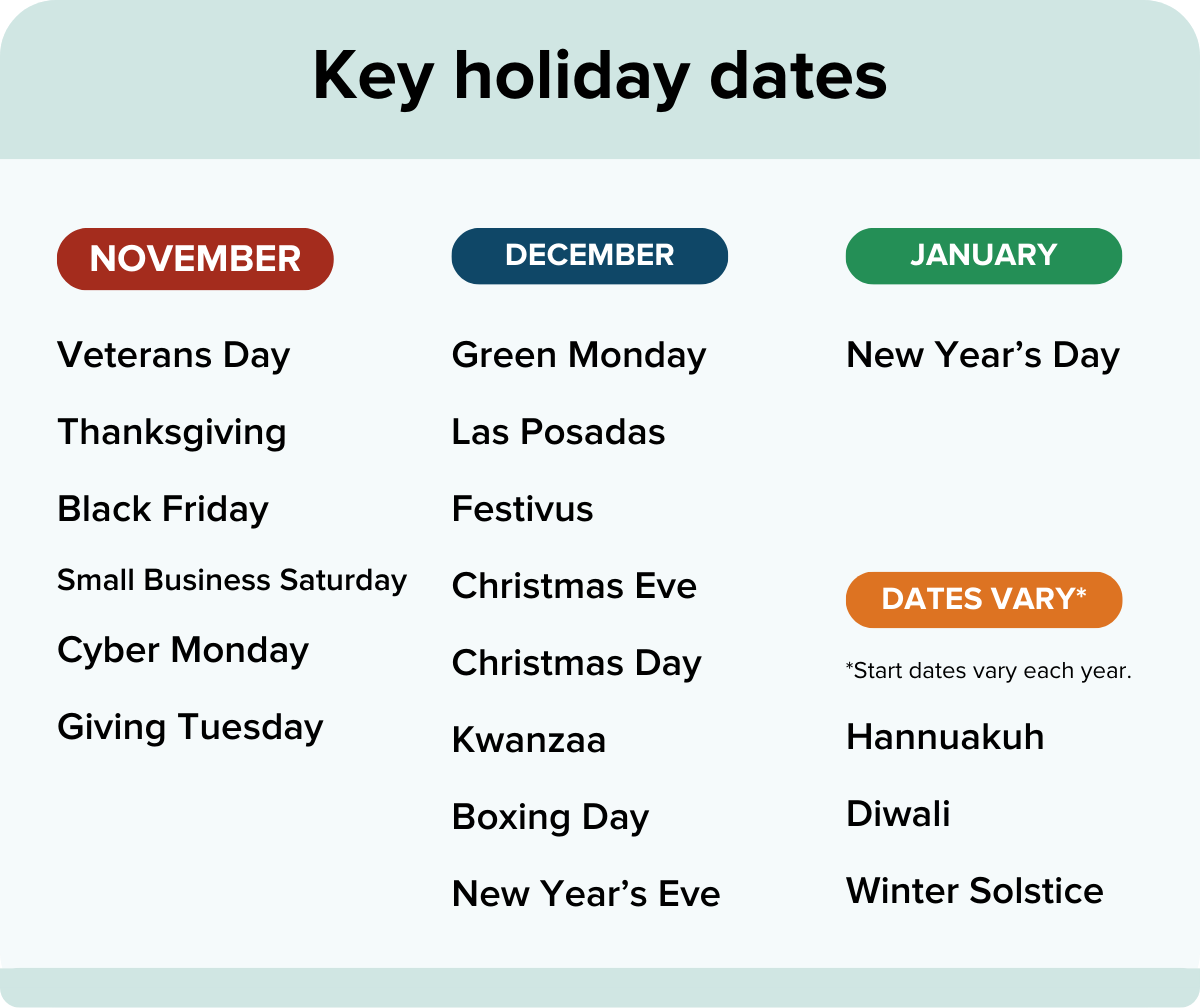
Each of these moments offers a chance to connect with your audience in a unique and relevant way. But how do you announce a holiday campaign in an email?
 Before launching a holiday-themed promotional campaign, take a moment to reflect on these important questions: Before launching a holiday-themed promotional campaign, take a moment to reflect on these important questions:
If you’re going to talk the talk, make sure you’re ready to walk the walk. Authenticity is key—don’t just capitalize on these holidays for revenue’s sake. Instead, focus on making a real impact that aligns with your brand’s values and genuinely supports the communities you’re spotlighting or celebrating. |
As Jaina Mistry (Director, Brand and Content Marketing at Litmus) puts it: “Think about how authentic your brand might come across to customers if you’re trying to force a connection.”
“Understand who your audience is, what they want, and choose seasonal campaigns that will bring all of that together. And in a crowded inbox where everyone’s trying to message around one very specific seasonal holiday, your brand will stand out by leveraging a topic that resonates better with your audience.”
The power of successful holiday email marketing
November and December aren’t just busy—they’re prime time for email engagement. Why? Over half of them are itching to pounce on early holiday deals. And if they’re on your email list, they’re primed to buy.
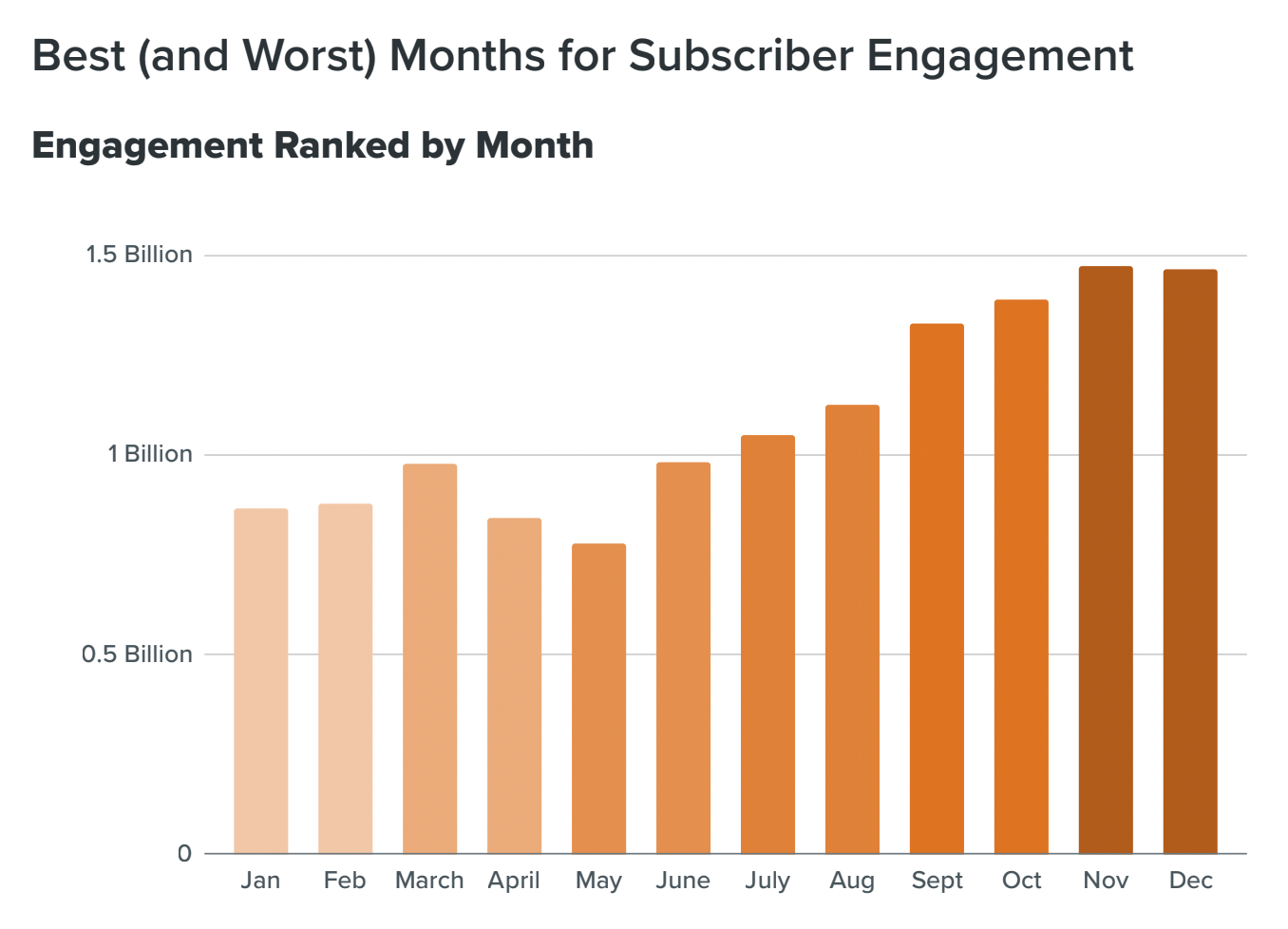
Here’s why your holiday campaigns matter:
- Eager audiences. Over half of consumers actively seek early holiday promotions.
- Extended season. Engagement opportunities stretch from October through January.
- Higher intent. By nature, email is a permission-based channel. Subscribers have opted-in to your email list because they want to hear from you—and they’re more likely to purchase than non-subscribers.
“Email outreach was reported by 29% of merchants to be their most effective marketing channel.”
How to build a winning holiday email marketing strategy
Creating an effective holiday email marketing strategy calls for thoughtful planning. Here’s how to hit the mark and close out Q4 with a major win.
Set clear, actionable goals
First, define what success looks like for your holiday campaign. Reflect on your business objectives from a macro perspective—e.g. how will our email campaigns support the larger picture? Set clear, measurable goals and key performance indicators (KPIs) that align with your overall business objectives.
These can include:
- Revenue targets. Set specific, achievable revenue goals based on historical data.
- Brand awareness. Measure increases in social mentions and overall visibility.
- List growth. Consider expanding your mailable audience during this high-engagement period.
If you’re in eCommerce, chances are you’re looking to increase revenue. Before mapping out your strategy, take a look at any historical data you have from previous holiday email marketing campaigns and benchmarks based on your own email performance metrics.
Plus, with a higher volume of sends, it’s a great time to A/B test new tactics that foster clicks and first-party data. Consider how email personalization for eCommerce can drive these efforts, enhancing your strategy for even better results.
If your goal is to boost brand awareness, consider leveraging your newsletters. They’re perfect for sharing resourceful, educational, and helpful content—the bread and butter of top-of-funnel (TOFU) marketing.
For specific holidays, you might include gift guides or spotlight brands and community members related to the occasion. Then, measure success by using a sentiment tracker to gauge how well your content is resonating with your audience. Plus, each vote counts as a click, inherently boosting engagement while collecting valuable feedback.
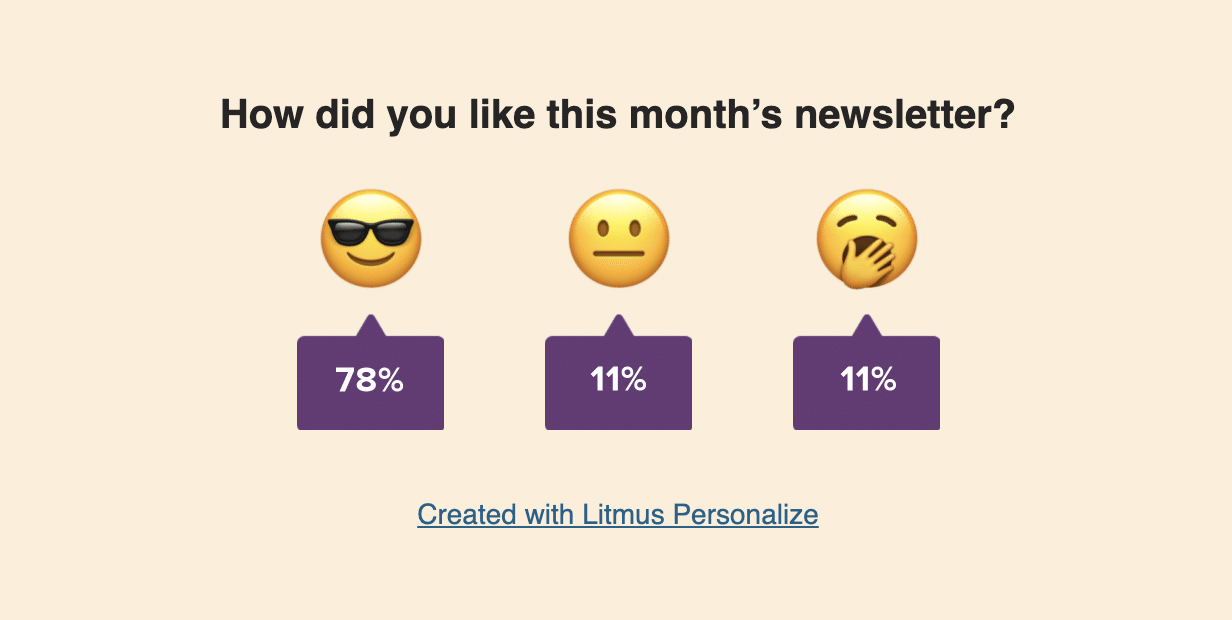
Segment your audience
There’s no such thing as sending “too many emails” if you’re segmenting effectively! Gone are the days of “batch and blast”—this holiday season, segmentation will be your best friend. 
Break down your list into targeted groups:
- Purchase history. Recent buyers, high-value customers, occasional shoppers
- Engagement level. Active openers, frequent clickers, dormant subscribers (e.g., clicked an email in the past two weeks vs. six months ago)
- Demographics. Age, location, occupation (if relevant to your products)
- Preferences. Product categories, content types, communication frequency
Consider additional factors for segmentation:
- Site behavior
- Zero-party data
- First-party data
- Webinar or event attendance
 Note: The holidays can be a sensitive time for subscribers. And while holiday opt-out emails have become popular in recent years, we advocate for allowing your audience to opt-in rather than opt-out. More on this →
Note: The holidays can be a sensitive time for subscribers. And while holiday opt-out emails have become popular in recent years, we advocate for allowing your audience to opt-in rather than opt-out. More on this →
Content creation
Now let’s dive into the heart of your campaigns: the content!
What should be the subject of a holiday email? It depends on a few factors. The key is to determine which type of email will resonate most with your audience segments.
Whether you’re planning content for a standard newsletter, a one-off promotional campaign, or an automated triggered email, assess which format will perform best.
For eCommerce retailers, a structured series of promotional emails might look like this:
- Announcement. Introduce the sale with an initial email, including an add-to-calendar link so they don’t miss out.
- Reminder. Notify subscribers that the sale is now live.
- Doors closing. Send a reminder email as the sale is nearing its end.
- Final minutes. Alert them that the sale is ending within 24 hours or an order-by deadline, with a countdown timer to introduce urgency and drive action.
- Sale extension. Inform them of a sale extension, if applicable.
You might also consider using a mix of soft-sell and hard-sell emails. Moment effectively employs this strategy with a series of emails featuring various themes and leveraging hierarchy (more on this next!):
- “Gift guide” email: The primary call-to-action (CTA) is the gift guide, with a secondary CTA to “shop the deals.”
- “Thank you” email: A more personal, letter-style email expressing gratitude and announcing an exclusive discount.
- Promotional email: A straightforward email highlighting the details of their holiday sale.
Scroll down to see each email in action.
“Gift guide” email example
Source: Really Good Emails
“Thank you” email example
Source: Really Good Emails
Promotional email example
Source: Really Good Emails
Design for impact
The holidays are a perfect time to embrace festive themes! You don’t need a major design overhaul—sometimes, just adding a few seasonal touches to your existing email templates can make all the difference.
Consult with your email designer and developer to explore what’s possible within your current email design system. Ask which elements can be elevated with a holiday touch. Remember, these updates don’t have to be a heavy lift.
Dress up your emails with holiday headers, like Food52 does:
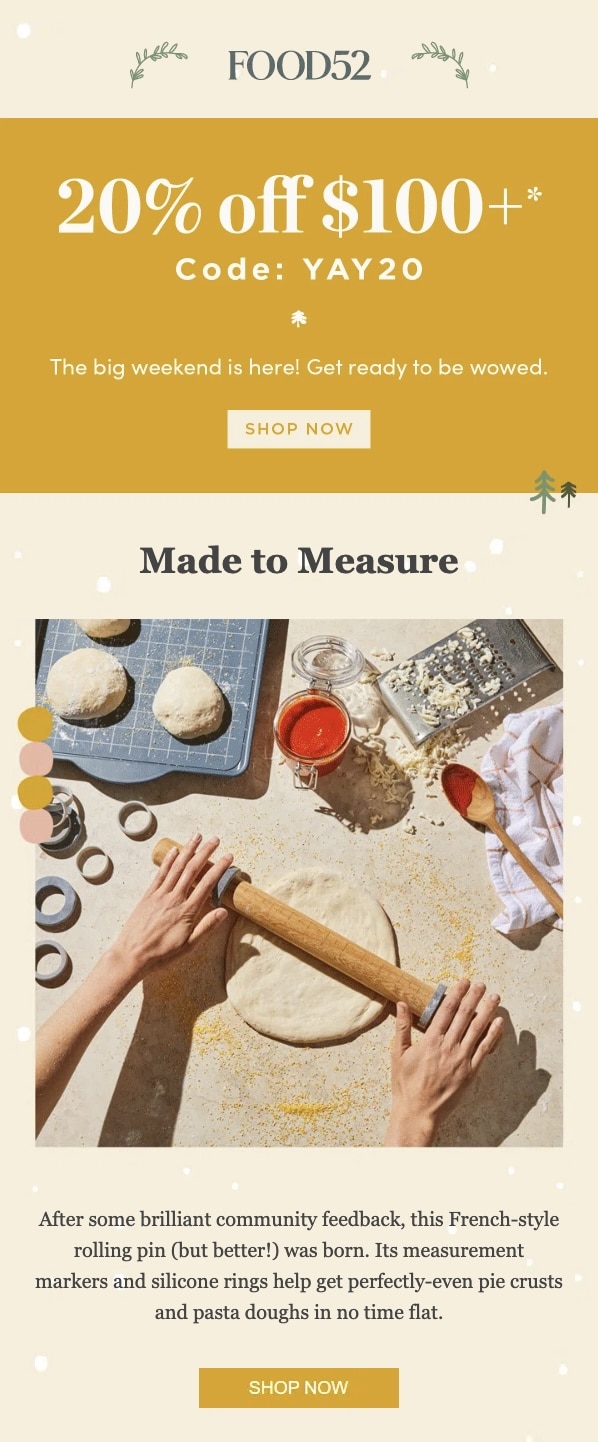
Here’s a side-by-side comparison of their normal header:
Below is an example of your monthly newsletter, Litmus News. See the differences between the holiday-themed newsletter (left) and the normal version we send (right)? We’ve added a few decorative elements like colored string lights and a background image featuring snowflakes. Modules were swapped in or out based on the content of the newsletter.
Beyond the look and feel, another crucial component to consider is hierarchy: visual differences that reinforce the importance and help readers quickly consume email content. On average, a subscriber spends 8.97 seconds with an email, so you’ll want to make sure your email has visual anchor points to make it easy for them to scan.
While it’s best practice for an email to focus on a single, primary message, some types, like newsletters, naturally include multiple key points.
For these emails, use hierarchy to clearly distinguish between your primary and secondary messages to help the reader quickly digest the most important parts of your email. This allows your main message to stand out, while still effectively incorporating additional content or email CTAs.

In the example below, Studio’s primary message announces its early Black Friday sale. Secondary messaging can be found above the hero image (e.g. “We’ve extended our returns until Jan 14”) and throughout the body of the email in the form of live polls.

Need help getting started? We’ve got you covered! Get started quickly with one of our free holiday email templates from our Email Template Hub—tested and approved by our very own email artisans.
Email distribution
How will your emails reach the right audience? Your holiday email marketing strategy can leverage a few key pieces:
- IP warm-up. If you’re anticipating a spike in email volume due to promotions, consider warming up your IP or domain. This involves gradually increasing the number of emails sent from your IP address or domain over time to ensure smooth delivery during the rollout of your holiday email campaigns.
- Promote it on social. If you’re offering exclusive content (like a special gift guide) or big sale, use social media to draw in new subscribers. Post about it to bring awareness to your holiday campaigns and incentivize sign-ups by offering early access or a discount, e.g. “be the first to know” or offer a special welcome discount.
- Segmentation. Tailor your email sends based on engagement levels. For example, use email personalization tactics like email scratch-offs or compelling holiday subject lines to boost open rates. Don’t forget to include segments that have specifically opted-in to receive holiday emails (e.g. via your preference center) and exclude those who have opted-out.
Clear timelines
The key for a stress-free holiday season is preparation! Create a timeline that includes key milestones, from content creation to design to final send. This will help you and your team avoid last-minute stresses and stay on track during this busy season.
Plan ahead.
We know its coming every year. Plan far ahead.
That includes scheduling time off
— Kisha @ EmailArtisan (@EmailArtisanIO) June 27, 2023
When should you send holiday marketing emails? You don’t want your emails to get lost in inbox clutter, but you also don’t want to miss the moment when your subscriber is ready to engage. That’s why identifying the best time of day to send emails is such a popular topic in email marketing.
Last we checked with Litmus Email Analytics, the morning—specifically between 10 a.m. and 11 a.m.—is consistently the prime time for email activity across six different regions, regardless of time zone, based on our analysis from August 2021 to August 2022.
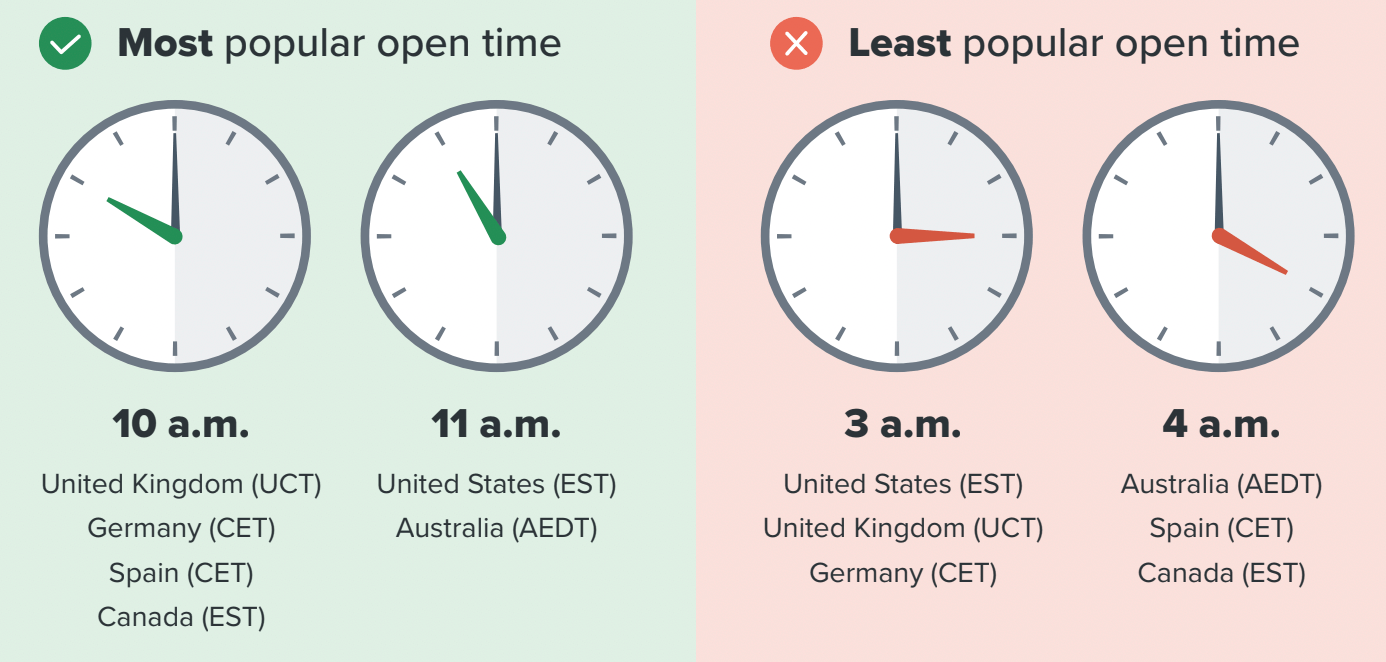
However, when we focused on email open patterns from 2.5 billion email opens between Thanksgiving and New Year’s Day 2021, we found that evenings were actually more effective. Specifically, 7 p.m. emerged as the peak time, accounting for an average of 9.45% of email opens.
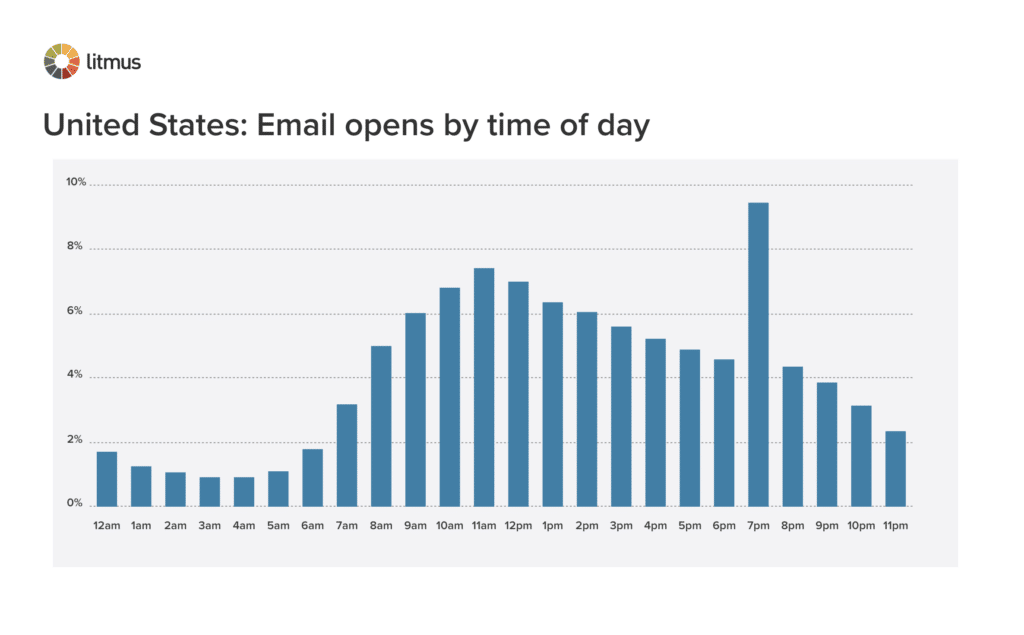
What does this mean for you? The answer to “when should you send an email” isn’t one-size-fits-all. Consider the following:
- Before your campaign launch, dive into any historical data you have on your audience pertaining to send time, usually available within your email service provider (ESP).
- Set a baseline for audience engagement. First, determine the most popular open times for your target audience. Use these insights to test and optimize your send times, checking if adjusting the timing improves email performance. Don’t focus solely on open rates; also monitor how different send times affect click rates and overall conversions.
- If your audience spans multiple time zones and important markets are spread out, segmenting your list by time zone can be a highly effective strategy.
- Factors like day of the week and when others are sending can impact how crowded inboxes are when you send. Experiment with the best times before your big send (perhaps you might consider a Saturday send!).
 LitTip: for more thorough insights like read rates and top email clients among your subscribers, use a third-party tool like Litmus Email Analytics to help inform your send time.
LitTip: for more thorough insights like read rates and top email clients among your subscribers, use a third-party tool like Litmus Email Analytics to help inform your send time.
Your holiday email timeline
Planning is the gift that keeps on giving. Here’s a timeline to keep you on track:
September:
- Finalize your overall strategy
- Start warming up your IP
- Begin designing templates
October:
- Launch list-building campaigns on social media
- Start teasing holiday content to your most engaged subscribers
Early November:
- Send your first holiday-themed newsletter
- Launch early bird promotions
Mid-November to December:
- Ramp up promotional emails
- Implement your main holiday campaigns
- Monitor and adjust based on performance
Late December:
- Transition to post-holiday sales and New Year messaging
Remember: flexibility is key. Be ready to pivot based on performance data and emerging trends.
Examples of successful holiday email marketing campaigns
A single well-crafted holiday email can create a snowball effect—leading to increases in revenue, brand loyalty, and long-term customer relationships.
Take for example Kate Spade’s holiday email marketing strategy, from a recent Black Friday email:
Source: Guide to Live Polls and Social Proof
The email was executed as a two-part send:
- The initial send: Kate Spade sent an email with a Litmus Personalize Live Poll paired with a progress bar, made up of spades to align with their branding. Every click registered as a vote (aka, invaluable first-party data). Each time a subscriber opened an email, they were guaranteed real-time results, as live poll results were updated with the latest results from subscribers casting their votes.
- The follow-up send: 24 hours later, Kate Spade sent a follow-up email, segmenting based on the subscribers who voted, based on their click category. Each recipient received an email with in-stock products based on their vote. Those who didn’t vote received an email containing best-selling items.
The results? As the marketing team at Kate Spade puts it, “This was a great strategy that really worked!” They saw:
- 84% increase in click-through rates (CTR)
- 12% increase in overall CTR
- 47% increase in revenue
- 140% growth in users year-over-year
Not too shabby, right?
“We increased CTR using the poll in email one and then had a bigger pool of engaged people to send a targeted, click-based follow up to. This was a great strategy that really worked!”
—Performance Marketing Manager, Kate Spade
Another route is to promote a list of limited-time gift ideas and special offers with a gift guide, like Urban Decay did for their Cyber Weekend deal. They featured a personalized image as the hero for a personal touch and included a live poll to gather social proof—just one of several dynamic email content examples you can try for your holiday campaigns.
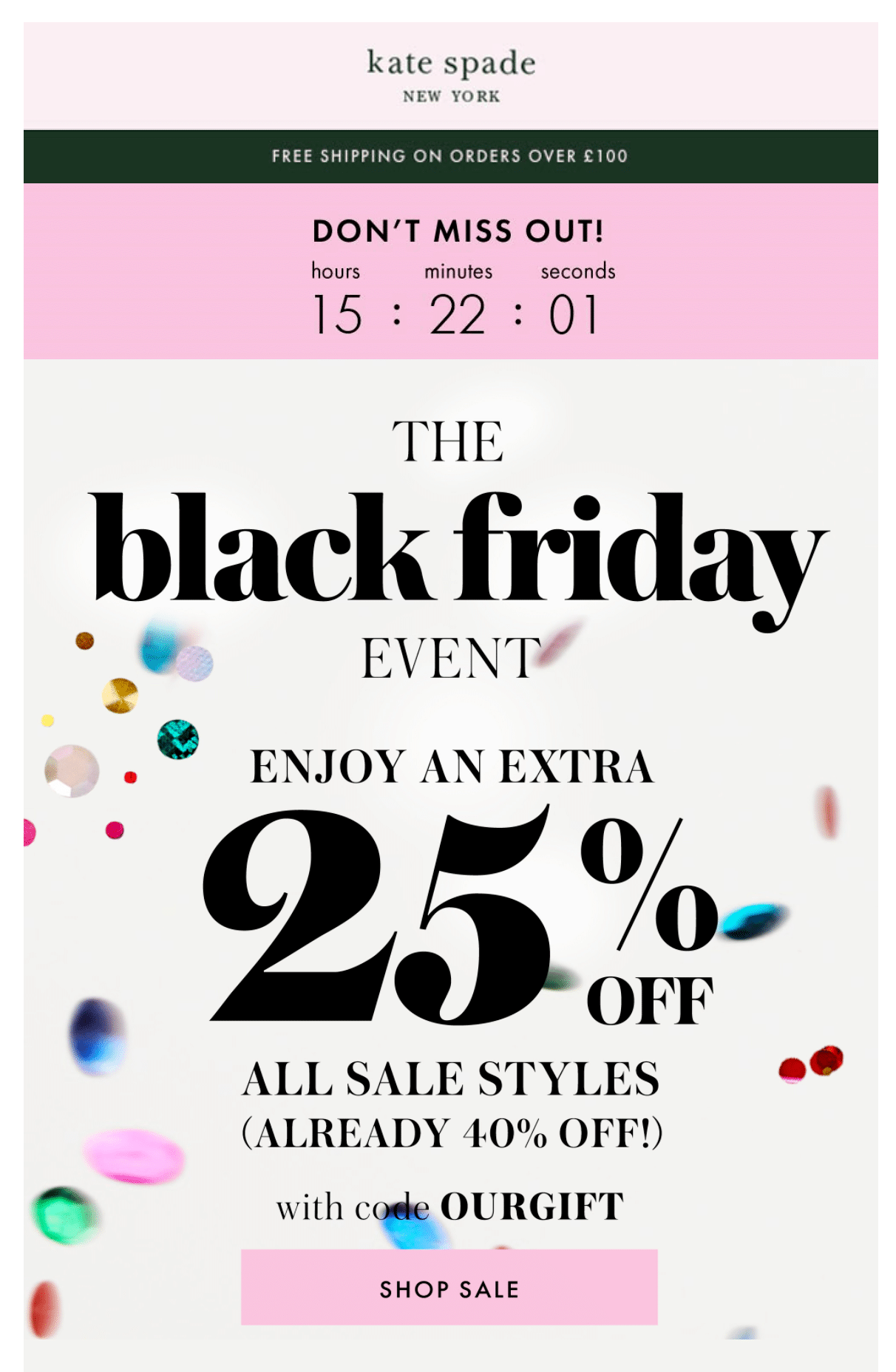
Another route is to promote a list of limited-time gift ideas and special offers with a gift guide, like Urban Decay did for their Cyber Weekend deal. They featured a personalized image as the hero for a personal touch and included a live poll to gather social proof—just one of several dynamic email content examples you can try for your holiday campaigns.
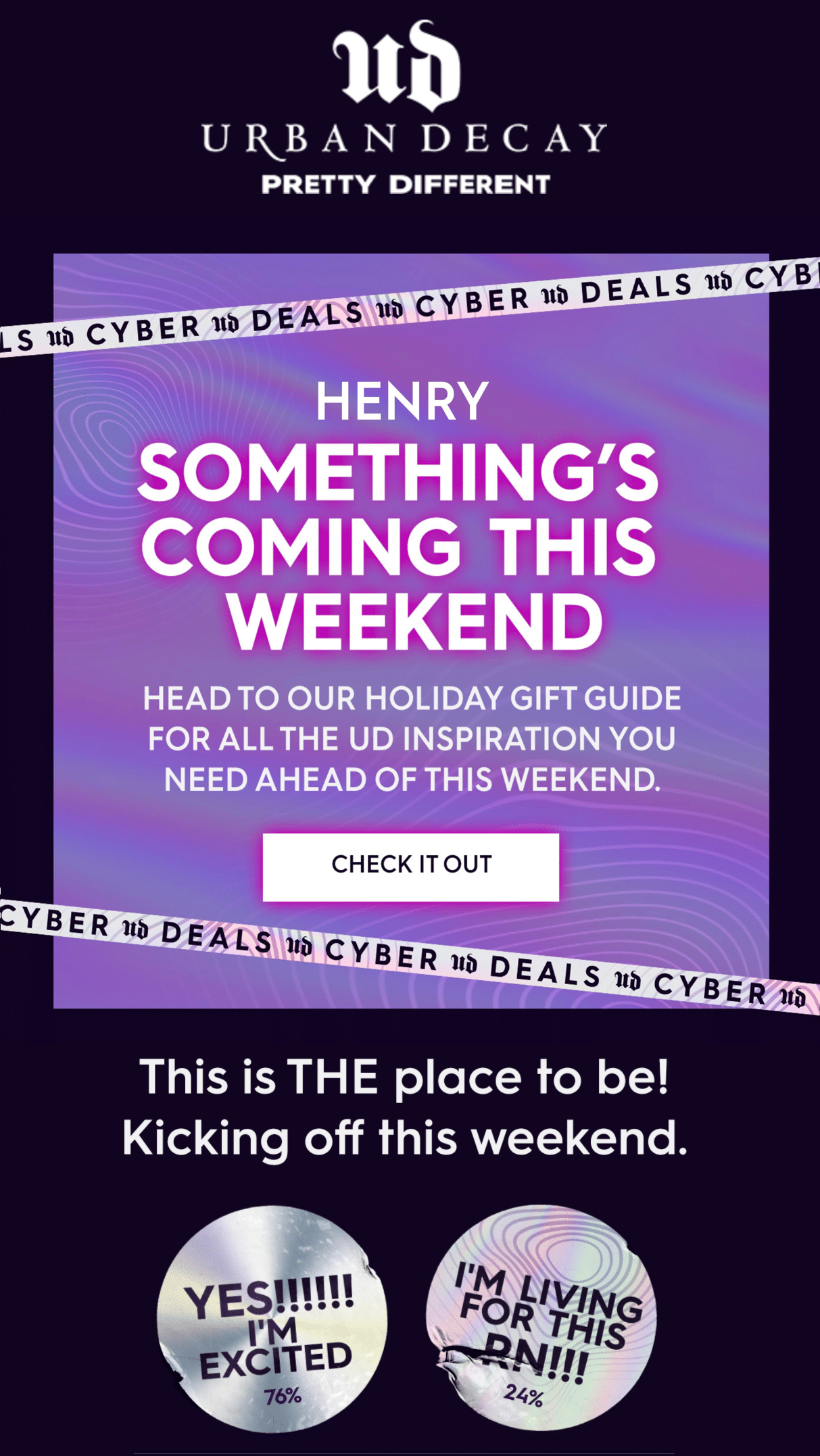
In another email, Urban Decay uses content automation to display imagery of and three recommended products.

With Litmus Personalize Quick-Start Templates, no coding experience is required to add personalized email elements like live polls, countdown timers, Scratch-Offs, Interest Signals, and Instagram Feeds. All it takes is a few clicks!

Want more holiday email marketing examples and tactics to apply to your campaigns this year? Check out our Holiday Email Marketing Guide. →
Best practices for holiday email marketing
Make the most out of this busy season with best practices to include in your holiday email marketing strategy:
Email personalization
Personalization can go a long way—especially in a crowded inbox. We’re talking 333 billion emails sent daily in 2022. That number is expected to rise to 392.5 billion by 2026.
Let’s break it down:
- 80% of consumers are more likely to make a purchase from a brand that provides personalized experiences.
- 64% of emails are sent by companies that leverage personalization using dynamic content. This means personalized emails are an industry standard.
Personalization works—that goes without saying. However it’s important to recognize that not all email personalization is created equal. Our latest research found that most marketers rely on basic personalization capabilities within their ESPs—like merge tags for text-based personalization (e.g. subscriber name, company, birthday). But with so many emails starting with a first name, is that really enough to make an impact?
Ensure your emails are connecting with your audience on a 1:1 level, and if possible, go beyond the basic text-based personalization that subscribers are accustomed to seeing, like “Hello, %%first_name%%.”
Today’s personalization is smarter, slicker—and dare we say, more fun.
This could look like:
- Interactive elements. Think digital scratch-offs revealing holiday deals. It’s like an advent calendar, but way cooler (and less waxy chocolate).
- Countdown timers. Nothing says “buy now” like a ticking clock. Use these for sale deadlines or shipping cut-offs.
- Live polls. Ask subscribers what they want for Christmas. They feel heard, you get data. Win-win.
- Add-to-calendar. Make sure your holiday sale doesn’t get lost in the shuffle. One click, and it’s on their calendar. Easy peasy.
- Rule-based images. Show the chocolate lovers a chocolate cake and the vanilla lowers a vanilla cake. It’s like mind-reading (thanks to zero- and first-party data), but legal.
- Interest Signals. “257 people bought this in the last hour!” Peer pressure works, folks.
- Real-time data feeds. Keep it fresh with auto-updating content. Because nobody wants last year’s leftovers.
- Personalized images. Instead of “Hello, %%first_name%%,” add their first name to an image to stand out from the masses.
Now, here’s where the magic happens: mix and match these features like you’re crafting the perfect holiday cocktail. Start with a base of solid segmentation, add a splash of behavioral triggers, and garnish with dynamic content. Always be testing and tweaking—what delights one group might fall flat with another.
The good news for email marketers is those who embrace real-time personalization are much more likely to create experiences that truly cut through the noise.
What does that look like in practice? Here are holiday email marketing examples for email inspiration this season.
First up: a Cyber Monday email from Hunter, featuring a countdown timer in the header to drive urgency.
Source: Email Gallery
Kate Spade kicks off a Black Friday email campaign with an announcement email, featuring an Interest Signal for social proof, “9,263 people are shopping Black Friday RN!”
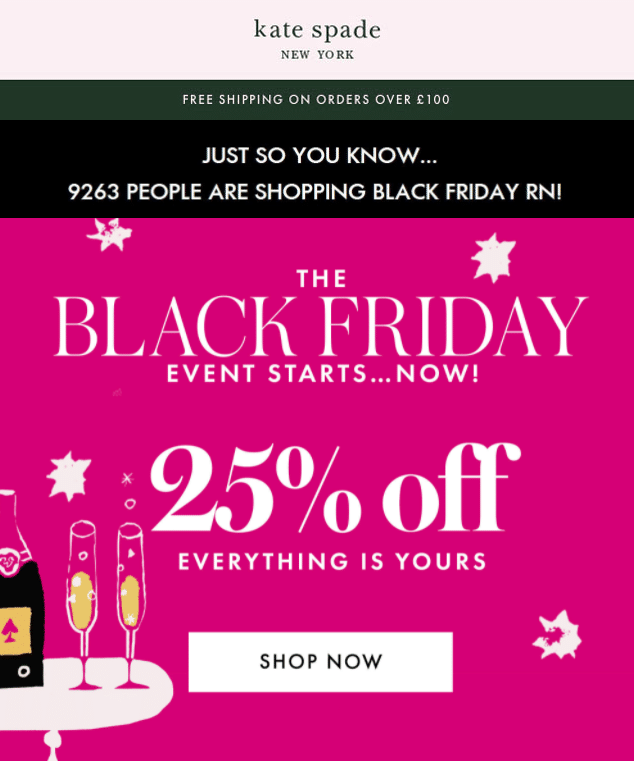
Mobiles.co.uk uses a personalized image with a live poll to tease an upcoming Black Friday email campaign, asking subscribers to “Vote for the type of deals you would like to see.” Each vote counts as valuable first-party data, providing subscriber insights and feedback about their products.
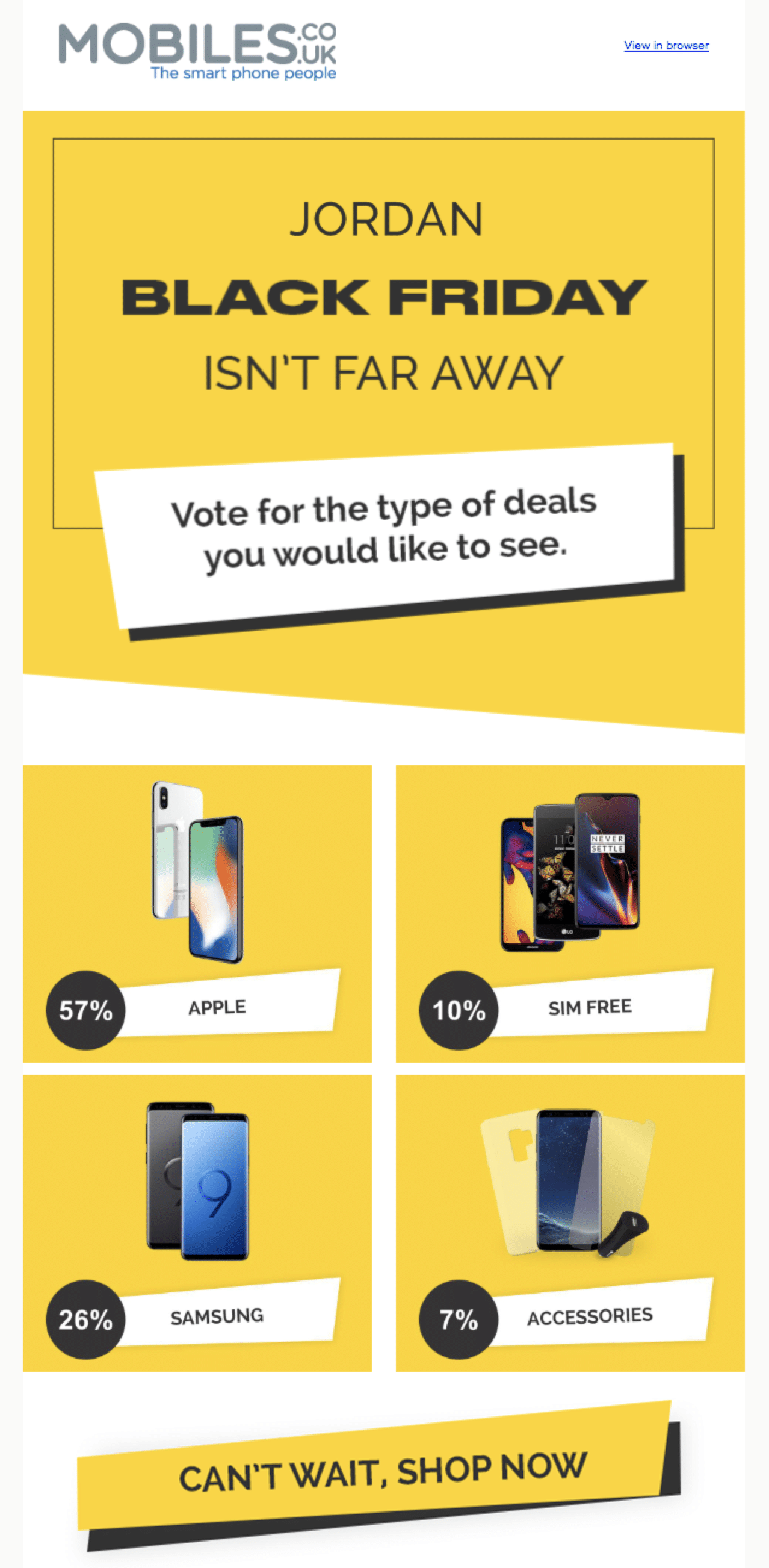
Studio kicked off the holiday season with a personalized image (“JORDAN” in the hero image) paired with the numbers of days left until Christmas in the form of a a countdown timer (an effective tactic that can yield results like a 32.5% engagement rate!).
Each time a subscriber opens, the timer updates with the appropriate number of days left.
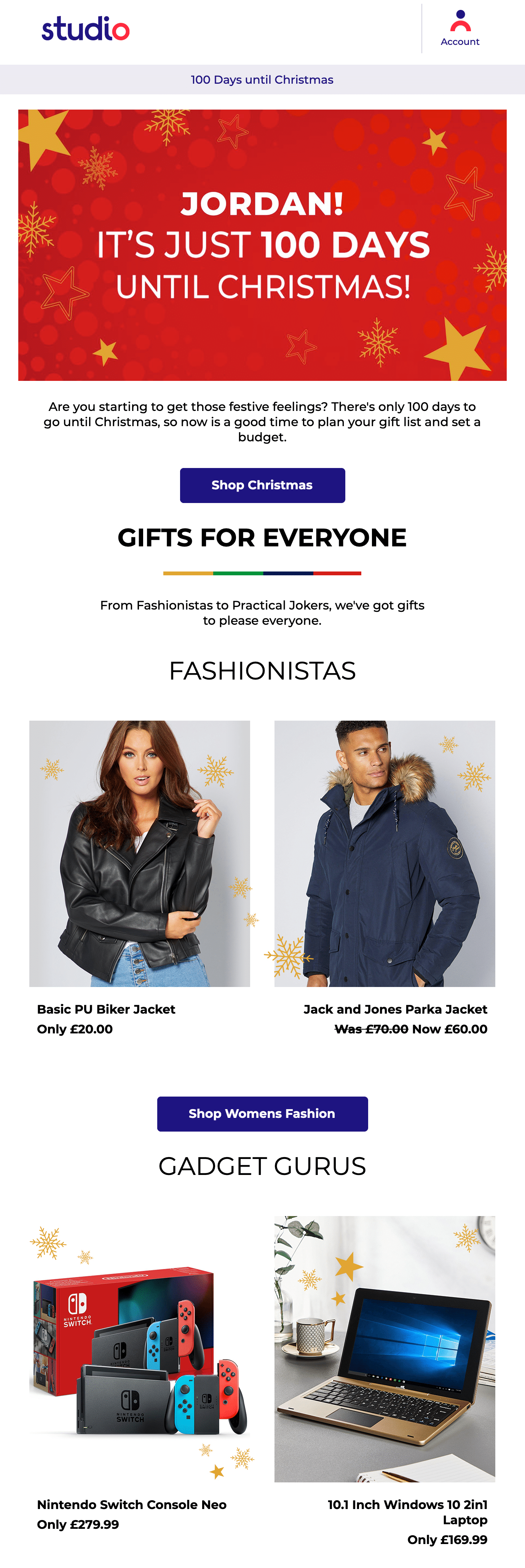
Mamas & Papas puts their Black Friday sale front and center as the primary message, followed by nearest store locations, which displays relevant store locations based on the subscriber’s location at the time of open.
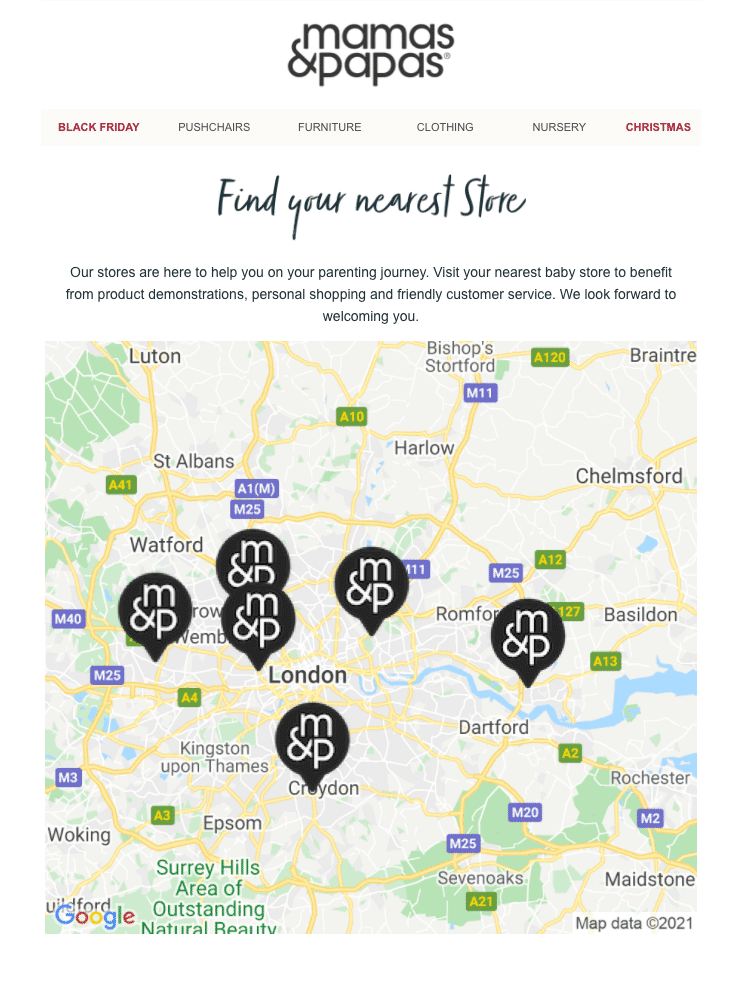
 LitTip: visit our Holiday Email Marketing Guide for more ideas and inspiration!
LitTip: visit our Holiday Email Marketing Guide for more ideas and inspiration!
This holiday season, don’t just send emails—create experiences. Make your subscribers feel like VIPs at the world’s best holiday party. Because when you nail personalization, you’re building relationships that last.
A/B testing
A/B testing should be done prior to holiday email marketing campaign planning, to set a reliable baseline for your holiday email marketing strategy. “This will ensure you’ve got the best versions of your emails going out during the holiday season—and ensures you’re not potentially missing 50% of your revenue with an A/B test where one version performs much worse than the other!” says Jaina Mistry.
There is one caveat to keep in mind: consumer behavior during peak holiday season will vary wildly compared to any other time of the year. “Consumers are looking for deals—not just for themselves, but for others for gifting. So while you may A/B test your way to awesome emails during the holiday season, the way consumers behave may not match how they usually behave.”
Beyond the usual tests like subject line and sender name, you might consider:
- Testing various design elements, such as a new layout, a new module arrangement (modular building makes this easy!), or tapping into an email design trend.
- Experimenting with your CTAs to see what drives more action. This can include A/B testing button styling, text styling, or copy.
- Testing personalized elements to see what brings in higher results, e.g. whether social proof or a live poll will yield a higher CTR (though we’re confident it will!).
“We conducted a series of A/B tests featuring Live Polls, and the outcomes were remarkably consistent—the live poll always outperformed! Because of the consistent performance of Live Polls, we have been able to roll out the Diamond Cut Showdown across the entire email list and gain valuable information about our subscribers’ preferences.”
—Lauren Jean, Email Specialist and Owner of ByLaurenJean
Email marketing automation
Triggered holiday emails might just be your secret weapon this season! It’s the perfect time to leverage email marketing automation for more effective campaigns. Take inventory of your current “on” campaigns and identify the opportunities that make the most sense for your email program. This might look like:
Abandoned cart emails
With faster purchase decisions during the holidays, time your abandoned cart emails just after the typical return period for cart abandoners.
How long does it take for the majority of cart abandoners to return to their cart on their own (without prompting)? However long that is for you, send your cart abandonment email a little after that time, so you’re nudging buyers along but not interrupting their normal buying behavior.
Browse abandonment emails
If you have access to data about website visitors, make it an integrated experience by setting up a triggered browse abandonment email. This could look like someone who spent time on a product page but failed to add anything to their cart.
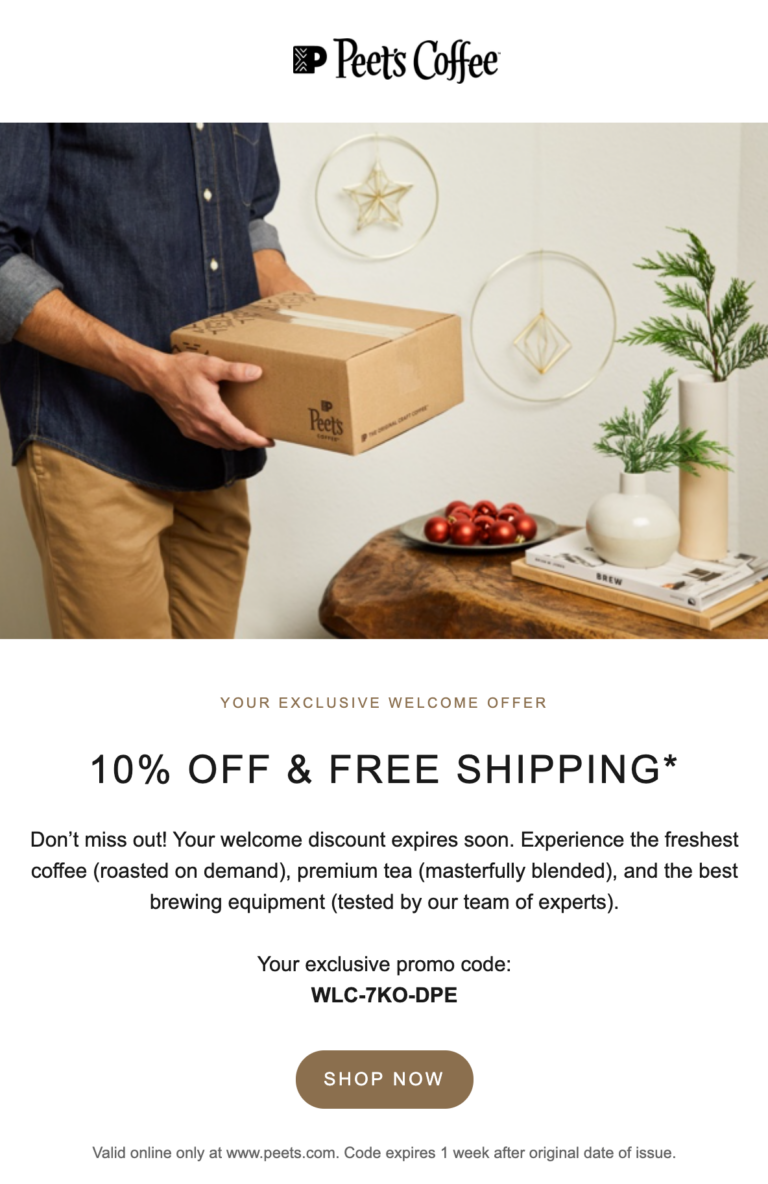
Inventory alerts
Inventory might move quickly, use back-in-stock trigger emails to notify subscribers who abandoned a page with an out-of-stock product, or signed up to receive an alert once they were back, like the example from Williams Sonoma:
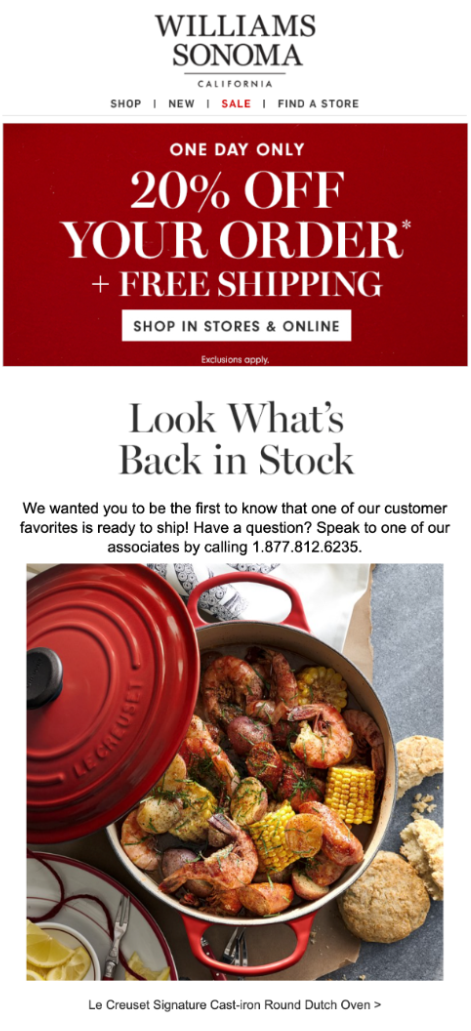
Welcome emails
These are some of the first emails a subscriber receives from your brand, so swapping seasonal imagery and copy can add the perfect holiday. You might also consider updating your welcome email offer to reflect the promotions you’re already running—e.g. offering a bigger discount for new subscribers than you would regularly, which is perfect for shouting about on your social channels!
Essential email tactics
Regardless of the season, remember to leverage tried-and-true tactics and strategies that are effective year-round.
- Always QA test your emails! During this competitive time in the inbox, a broken image or link can harm your brand—and conversions. Stay vigilant with email testing into your workflow to ensure your emails stay pixel-perfect (and lean on Litmus Email Guardian to keep a 24/7 watch over your emails!)
- Avoid using misleading subject lines. Refrain from tactics that falsely suggest ongoing conversations, such as using a faux “Re:” in the email subject line when it’s the first email you’re sending. Ensure you follow through on the message you’re delivering in the subject line and preview text and avoid bait-and-switch techniques.
- Ensure your emails are optimized for Dark Mode. Dark Mode adoption has increased steadily over the years—our latest research found an average of 35% of email opens were in Dark Mode. Don’t alienate those subscribers and leave them in the dark.
- Keep email accessibility top of mind. Ensure everyone can receive and understand your message, regardless of any disabilities or assistive devices they may be using. (
 LitTip: Email testing with Litmus includes accessibility checks for color vision deficiency and more!)
LitTip: Email testing with Litmus includes accessibility checks for color vision deficiency and more!) - A/B test and optimize. Experiment with subject lines, preview text, CTAs, and personalization tactics to refine your email content.
- Reward loyalty: Offer discounts and free shipping to loyal customers to encourage additional purchases.
- Simplify purchasing: Make it easy for subscribers to buy by linking directly to your purchase page from your emails.
How to avoid the common pitfalls of holiday email marketing
There’s a lot on an email marketer’s plate during the holidays. Here are some email marketing tips to help avoid some of the most frequent pitfalls:
- Excessive sending. Avoid the “batch and blast” mentality: balance your frequency to maintain engagement without overwhelming your audience—otherwise, this will lead to fatigue and unsubscribes. Balance your frequency to maintain engagement without overwhelming your audience.
- Using generic messaging. Avoid vague, one-size-fits-all content—and personalize beyond merge tags, if you can. With Litmus Personalize Quick-Start Templates, all it takes is a few clicks to set up real-time personalization—like live polls and countdown timers!
- Ignoring data. Neglecting to use your data can result in missed opportunities! Use any zero-party data collected from preference centers and first-party data from live polls and Interest Signals for a more refined segmentation strategy.
- Ignoring mobile optimization. Ensure your emails are responsive and mobile-friendly to ensure your emails look great and be easily readable on all devices. Need help in this department? Check out these free email templates—all optimized for mobile devices and Dark Mode.
- Using a pre-flight checklist. Have you ever opened an email only to find that a link isn’t working, images aren’t loading, or personalization is off? An email checklist will help you mitigate common email mistakes, ensuring your holiday emails are set up for success..
Measuring the success of your holiday email marketing campaigns
The major holiday season comes around once a year, and while it can be a busy time, tracking all the details provides invaluable insights for future holiday campaigns and your email program as a whole.
Tracking the right metrics
The “right” metrics will vary depending on the goal of your holiday email marketing campaigns. Is it to drive revenue—or even brand awareness?
While email marketing is generally thought of as a middle-of-funnel (MOFU) or bottom-of-funnel (BOFU) channel, it can certainly help drive awareness, too.
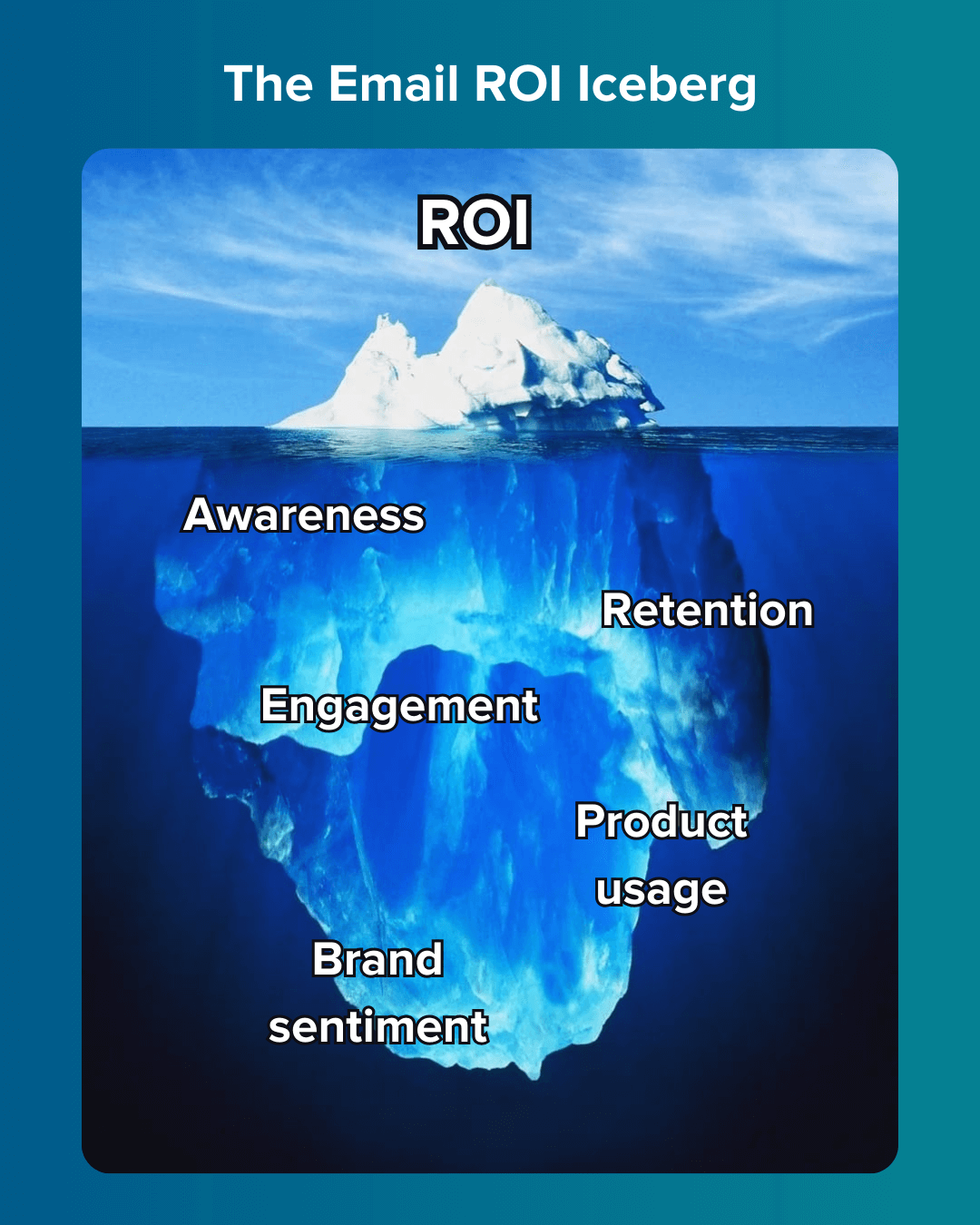
Email is a permission-based channel and so inherently, your audience is giving you permission to send marketing communications to them. To build a relationship with your email audience, you need to show up consistently in the inbox to drive and maintain brand awareness.
A format that works well for this is newsletters. They’re an excellent vessel for sharing high-value content that’s resourceful, educational, and helpful. Plus, newsletters work: they’re the common type of emails that marketers send (especially with the surge in paid newsletters over the past few years).
That said, depending on what your broader goal is, consider the following:
| Top of the funnel | Email list size, open rate, number of clicks, read rate or read time |
| Middle of the funnel | CTR, a low unsubscribe rate, read rate or read time |
| Bottom of the funnel | CTR, conversion rate (CVR), revenue per email (RPE), revenue per subscriber (RPS), subscriber lifetime value (LTV), return on investment (ROI), forward rate/email sharing |
Leveraging the best tools
Speaking of metrics, Litmus Email Analytics can help you drill down to the nitty-gritty of subscriber engagement. You can get access to insights on whether a subscriber read, skimmed, or glanced at your email.
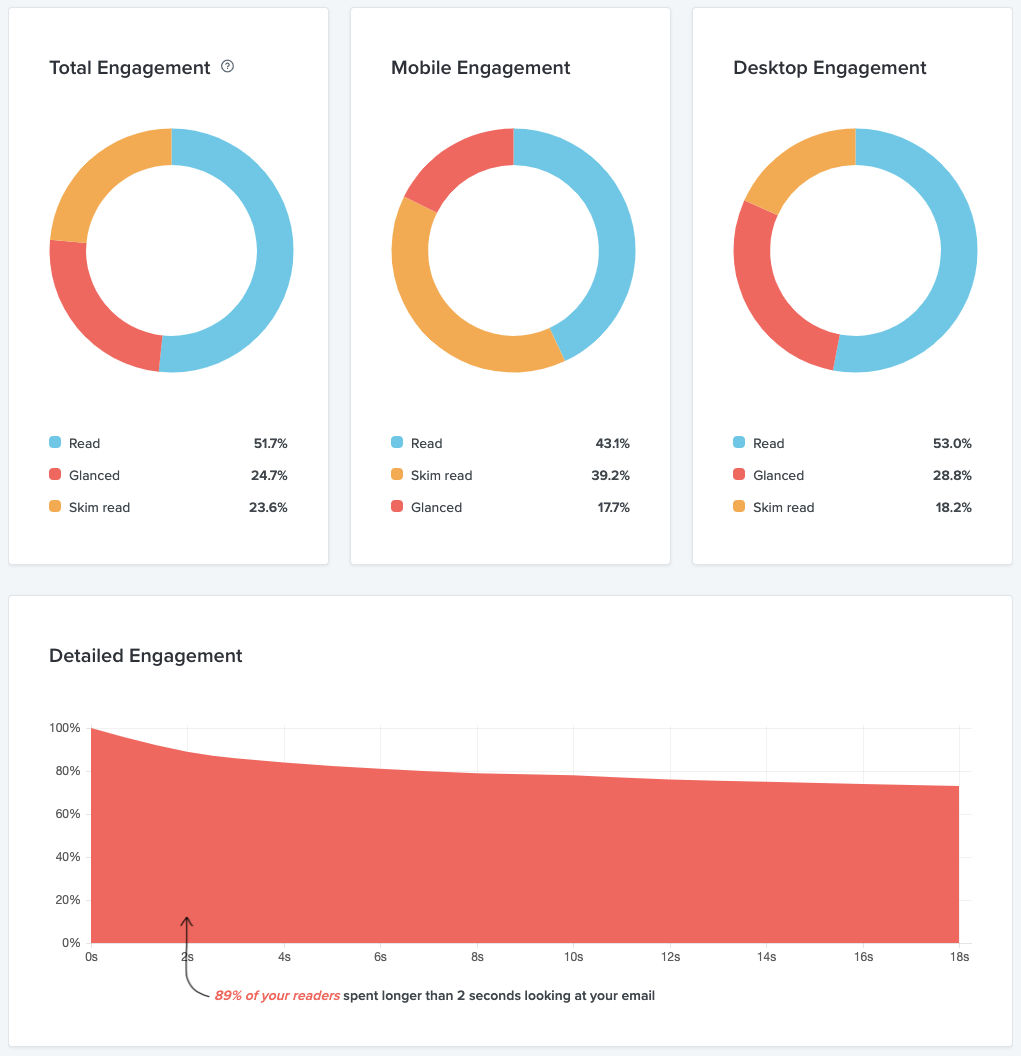
Another tool we recommend? Litmus Personalize! With it, you’ll get access to a library of quick-start templates that make email personalization a quick and easy to create. No coding experience is required to create Scratch-Offs, live polls, countdown timers for your emails. All it takes is a few clicks!
Iterating on learnings and wins
Take the time to document your learnings—what worked, what didn’t, and why. Identifying trends and successes can provide a clear roadmap for future campaigns. Evaluate your email performance with your reporting format of choice (like an email reporting template!).
Consider hosting a post-mortem meeting after the holiday rush to reflect on your findings, discuss key takeaways, and strategize for the next year.
The post How to Create a High-Performing Holiday Email Marketing Strategy appeared first on Litmus.
https://www.litmus.com/blog/litmus-holiday-marketing-guide
